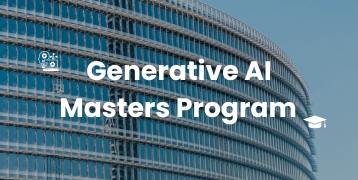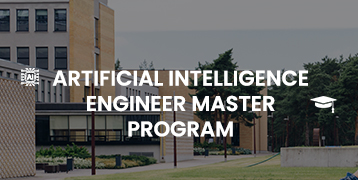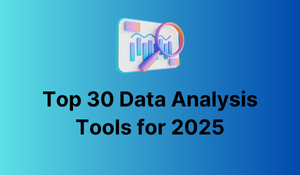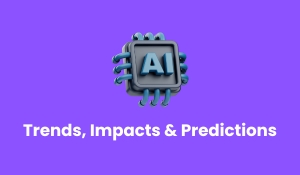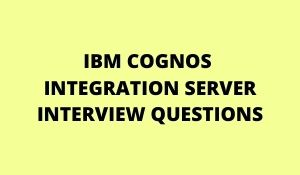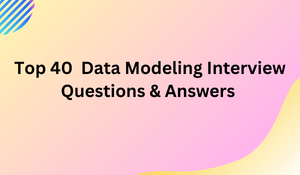
1. What is data modeling?
Data modeling is the process of creating and arranging data to produce a database blueprint. It entails defining entities, their qualities, and their relationships. This methodical methodology guarantees data correctness, consistency, and efficiency. Data modeling assists in the creation of conceptual, logical, and physical representations of data, hence facilitating successful database construction and maintenance.
For More Info: What is data modeling?
2. Explain various types of data models
There are three main types of data models: relational, dimensional, and entity-relationship (E-R). Additionally, there are less common models like hierarchical, network, object-oriented, and multi-value. These models determine the logical structure, influencing how data is stored, organized, and retrieved in databases.
3. What is metadata?
Metadata is data that describes and situates other data. It contains information such as data kind, creation date, and source, which aids in understanding, organizing, and exploiting the linked data.
4. What is data mart?
Data Mart is a subset of a data warehouse, focusing on specific business functions or departments. It stores and presents relevant data for analysis, facilitating targeted decision-making within a smaller scope.
5. What is forward data engineering?
Forward Data Engineering involves creating and implementing data pipelines to process and transform raw data into a format that can be used for analytics or other reasons. It focuses on data flow from source to destination, providing efficient and effective forward processing of information.
6. What is PDAP?
Praedico Data Platform is an abbreviation for Praedico Data Platform in DBMS. It is a data cube used to store data in summary form. The data in PDaP is saved so that users may easily report on it. The main advantage of PDaP is that it functions as a data cube, keeping data as a summary and allowing users to rapidly evaluate data.
7. What is a Table?
In a database, a table is a structured arrangement of data organized into rows and columns, representing entities and their attributes in a relational database management system (RDBMS).
8. What is cardinality?
Cardinality in data modeling refers to the numerical relationships between entities in a database. It defines the number of instances of one entity that can be related to a single instance of another entity. Cardinality is often expressed as one-to-one, one-to-many, or many-to-many, indicating the possible associations between entities.
9. What Does the Data Modeler Use Normalization For?
A data modeler employs normalization to effectively organize a database, decrease redundancy, and improve data integrity. It removes anomalies and dependencies, resulting in a more streamlined, reliable, and manageable database design.
10. What is discrete and continuous data?
Discrete data is made up of unique, distinct values with no significant values in between (e.g., integers, and counts). Continuous data is measured on a continuous scale and can take any value within a specific range (e.g., height, weight, and temperature).

11. What is the time series algorithm?
Time series algorithms analyze sequential data over time, forecasting trends. Common methods include ARIMA, ETS, and LSTM, which leverage historical patterns to predict future values in fields like finance and weather forecasting.
12. What Does ERD stand for, and what is it?
ERD stands for Entity-Relationship Diagram. It is a graphical depiction of the structure of a database, displaying entities (such as tables), characteristics, and the relationships between them. ERDs aid in the design and understanding of database systems by illustrating how data pieces relate to one another in a clear and straightforward manner.
13. What is the Enterprise Data Model?
Enterprise Data Model is a structured framework that defines and organizes an organization’s data assets, relationships, and business concepts. It ensures a standardized and unified understanding of data across the entire enterprise.
For More Info: Enterprise Data Model?
14. Explain the Two Different Design Schemes.
In database design, there are two primary schemas: the logical schema focuses on the organization’s conceptual view, defining entities, relationships, and constraints, while the physical schema concentrates on implementation details, specifying how data is stored, indexed, and accessed. The logical schema represents the “what” of the database, while the physical schema represents the “how” in terms of storage and access mechanisms.
15. What is a Slowly Changing Dimension?
In data warehousing, a slowly changing Dimension (SCD) is a dimension that changes gradually over time, with data properties updating regularly. SCDs aid in the preservation of historical records, allowing for the investigation of how data in a dimension has changed and evolved.
16. What is Granularity?
Granularity in data signifies the extent of detail or precision. High granularity includes detailed information, like individual records, while low granularity involves fewer, summarized data points. This differentiation significantly impacts data analysis, utilization, and the resulting accuracy and effectiveness of outcomes.
17. What Are Subtype and Supertype Entities?
Subtype and supertype entities are database design principles in which a supertype (generalized) object includes one or more subtype (specialized) entities. The supertype specifies common properties, which subtypes inherit and supplement with specialized ones. This modeling method makes it possible to represent many things inside a cohesive framework. A “Vehicle” (supertype) may contain subtypes such as “Car” and “Motorcycle,” which share similar qualities while having distinct characteristics particular to each subtype.
18. What is Confirmed Dimension?
In data warehousing, a Confirmed Dimension is a dimension table that is consistent and agreed upon throughout an organization, guaranteeing uniformity in data representation and simplifying reliable reporting and analysis.
19. What’s a Junk Dimension?
A junk dimension is a practical consolidation of low-cardinality flags and indicators that are removed from the fact table and placed in a separate dimension table. This table contains features such as text, flags, or basic indications that do not fit into current dimensions, allowing for more efficient data arrangement in a dimensional framework.
20. What is the Entity Relationship diagram or ERD?
An Entity-Relationship Diagram (ERD) is a visual representation of a database’s structure, illustrating entities, their attributes, and relationships. It provides a clear and concise overview of how different data elements are connected and organized in a relational database. ERDs are instrumental in designing, understanding, and communicating the conceptual framework of a database system during the development process.
21. What are the uses of enterprise data modeling?
Enterprise data modeling ensures consistent and standardized representation of data across an organization, facilitating understanding, communication, integration, data governance, decision-making, efficiency, and documentation of data-related processes and structures.
22. What is relational data modeling?
Relational data modeling is the process of structuring data in a relational database. It involves identifying entities, defining their attributes, and establishing relationships. This model ensures efficient data organization, retrieval, and maintenance, adhering to the principles of the relational database management system.
23. What is OLTP data modeling?
OLTP (Online Transaction Processing) data modeling involves designing databases for swift and precise transactional operations. It focuses on optimizing the processing of day-to-day transactions, ensuring efficiency in data entry, retrieval, and modification.
24. What is the difference between starflake and snowflake schema?
The starflake schema is a hybrid between the star and snowflake schemas in data warehousing. It maintains the simplicity of the star schema for improved query performance but normalizes some dimensions like the snowflake schema to reduce redundancy. While the star flake schema strikes a balance between simplicity and normalization, the snowflake schema fully normalizes dimension tables, potentially improving data integrity but at the cost of increased complexity and potentially slower queries compared to the star schema.
25. What is data sparsity and how does it affect aggregation?
Data sparsity refers to the presence of many empty or undefined values in a dataset. In aggregation, sparse data can lead to incomplete or inaccurate results as aggregating across missing values may not provide a meaningful representation. It necessitates careful handling and consideration of missing data during aggregation processes.
26. What is normalization?
Normalization is the database design process that minimizes data redundancy and dependency by organizing tables and establishing relationships. It enhances data integrity and reduces duplication within a relational database structure.
27. What is De-Normalization?
De-normalization is the process of deliberately introducing redundancy into a database by combining tables or including redundant data. This is done to improve query performance and simplify database design.
28. What are the types of normalization?
Normalization types include First (1NF), Second (2NF), and Third Normal Forms (3NF). Additionally, there’s the Boyce-Codd Normal Form (BCNF), addressing certain anomalies, and the Fifth Normal Form (5NF), handling specific cases for optimal database organization and integrity.
29. What is the First normal form?
First Normal Form (1NF) ensures that each table cell contains atomic, indivisible data, eliminating duplicate columns. It establishes the foundation for organized and non-redundant data in a relational database, allowing for efficient data retrieval and management.
30. What is the second normal form?
The second Normal Form (2NF) builds on 1NF by removing partial dependencies. It ensures that all non-key attributes are fully functionally dependent on the entire primary key, minimizing redundancy and enhancing data integrity in a relational database.

31. What is the third normal form?
The third Normal Form (3NF) goes further by eliminating transitive dependencies, ensuring that non-key attributes are independent of each other. This minimizes redundancy, enhances data integrity, and streamlines the relational database structure.
32. What is the definition of a foreign key constraint?
A foreign key constraint in a relational database ensures referential integrity by linking a column or a set of columns in one table to the primary key of another table. It enforces that values in the foreign key match existing values in the referenced table’s primary key.
33. What do you understand by data models?
Data models are abstract representations of how data in a database is arranged and connected. They specify the data’s structure, relationships, and limitations. The most common categories are conceptual, logical, and physical models. These models serve as a template for creating and implementing databases that store, retrieve, and manage information effectively.
34. What is a hierarchical database management system?
A Hierarchical Database Management System organizes data in a tree-like structure, where each record has a parent-child relationship. Parent records can have multiple child records, creating a hierarchical arrangement. This model is efficient for certain types of data with inherent hierarchical relationships.
35. What do you understand by a data mart? Discuss the various types of data marts available in data modeling.
A data mart is a subset of a data warehouse that focuses on specific business areas or user groups. Two main types are:
Dependent Data Mart: Directly derives data from the data warehouse.
Independent Data Mart: Stands alone, sourcing data independently.
36. Differentiate between OLAP and OLTP databases.
OLAP (Online Analytical Processing) databases are designed to enable decision-making through complicated queries and data analysis using aggregated and historical data. OLTP (Online Transaction Processing) databases, on the other hand, are focused on transactional duties such as data entry and retrieval for everyday company operations. OLAP is read-heavy, with an emphasis on analytical processing, whereas OLTP is write-heavy, with an emphasis on real-time transactions. The distinction is based on its architecture, optimization aims, and the kind of jobs best suited for in a database system.
37. Do all databases need to be rendered in 3NF?
No, not all databases need to be in the Third Normal Form (3NF). The level of normalization depends on the specific requirements of the application. While higher normal forms reduce redundancy, they may not be necessary for every scenario, especially in cases prioritizing performance or simplicity over normalization.
38. Why are NoSQL databases more useful than relational databases?
NoSQL databases are more useful than relational databases in certain scenarios due to their flexibility, scalability, and ability to handle unstructured or semi-structured data. They excel in distributed and large-scale environments, providing faster and more efficient performance for specific use cases like real-time analytics, content management, and handling diverse data types. However, the choice between NoSQL and relational databases depends on the specific requirements of the application.
39. What qualities are needed in a good data model?
A good data model should be accurate, clear, consistent, complete, flexible, scalable, maintainable, efficient, relevant to business needs, and follow normalization principles to reduce redundancy and enhance data integrity.
40. What is the difference between the hashed file stage and the sequential file stage in the Data Stage Server?
In DataStage Server, the Hashed File Stage is designed for high-performance lookup operations, utilizing hash functions for quick data retrieval. It’s efficient for joining and looking up tasks. In contrast, the Sequential File Stage is used for basic read/write operations, processing data sequentially. While the Hashed File Stage is optimized for complex operations, the Sequential File Stage is straightforward for simpler data-handling tasks.
GoLogica Technologies offers you a great way to showcase your level of skills and areas of expertise with industry-level projects and fast-track your career with a Data modeling certificate.
| BIG DATA ANALYTICS TRAINING | IBM DATASTAGE TRAINING |
| PEOPLESOFT DATA MANAGEMENT TRAINING | Talend Big Data Training |
| DataStage Administrator Training | and many more… |
Related Articles:
🎯 Data Modeling Tutorials
🎯 7 Data Modeling Techniques and Concepts for Business
🎯 Business Leaders Need to Know About Data Modeling
🎯 Importance of Data modeling and using different Technologies in Data Modeling
🎯 Overview, Basic Concept, and Types in Details On Data Modelling
🎯 What is the best data modeling Tool to use in 2024?

